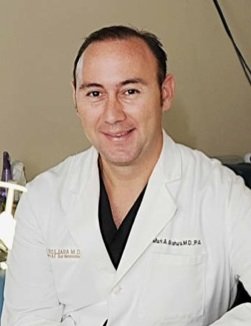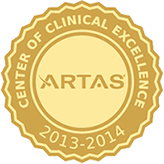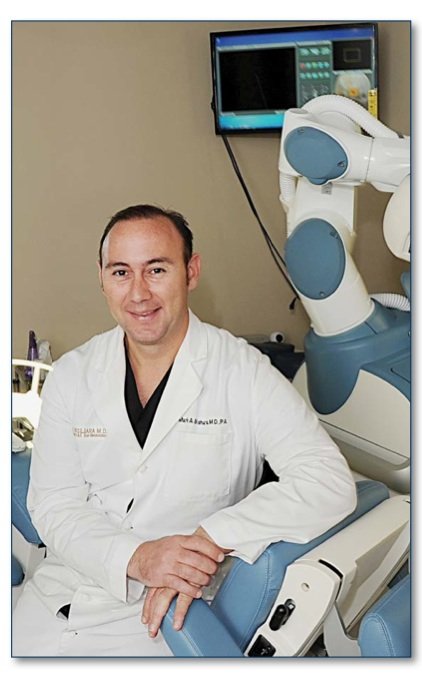Recently, Restoration Robotics launched ARTAS Hair Studio. This state of the art product allows the patient and surgeon plan and produce a simulation of a possible outcome. Although this product has some limitations to the realistic look of the transplanted hair, it does allow for a formal interaction between the surgeon and the patient that spawns more thought into the over- all operative goal and leads to increased numbers of hairs being transplanted.
The most common cause of dissatisfaction of hair transplant patients in my practice and in patients that come to me from other practices is that they didn’t get the thickness that they wanted. The ARTAS Hair Studio allows the patient to “Test Drive” their appearance and modify the operative plan under the guidance of the surgeon. It becomes the surgeon’s ethical and responsible role to provide guidance on safe and age appropriate hairline design, donor capacity, and realistic expectations on social and physiologic downtime. The ARTAS Hair Studio becomes paramount providing a sneak preview to esthetic results that vary with amount of hair.
Put together with a well informed consult discussing preventative hairless measures backed by randomized double-blinded placebo controlled trials, the ARTAS Hair Studio is quickly becoming the standard of care in hair restoration planning and patient education.
ARTAS Hair Studio also integrates directly with the robot and becomes the operative plan for the patient ensuring that the patient is receiving exactly what he is intending to recieve.
For a consultation please call 817-473-2120 or email appointments@markbisharamd.com. Skype and other internet-based consultations are available.
Mark A Bishara M.D., P.A. and Paragon Hair Clinics care for patients world-wide.
Dr. Mak A Bishara, M.D. P.A. performs robotic follicular unit graft selection for residents living around Mansfield, Southlake, Dallas, Arlington, Fort Worth, and surrounding the DFW area in North Texas.
Posts
How many hairs come out of a graft area?
Is it harder to transplant African American hair? Does it take to the new site as well? Does it take longer? Have you performed any transplants on African Americans?
Please give us a call 817-473-2120 or email us at Appointments@markbisharamd.com
What is a Robotic Hair Transplant?
 A robotic hair transplant is a type of hair restoration procedure where donor hair is removed directly from the back and sides of the scalp using robotic control. The specific type of hair transplant where robotic technology is used is called follicular unit extraction (FUE). In FUE, a small, round instrument, or punch, is use to separate individual follicular units (naturally occurring groups of 1-4 hairs) from the surrounding tissue, so that they can be extracted and then implanted into the balding area. This process is very tedious and exacting and when done manually often leads to significant injury to the follicles.
A robotic hair transplant is a type of hair restoration procedure where donor hair is removed directly from the back and sides of the scalp using robotic control. The specific type of hair transplant where robotic technology is used is called follicular unit extraction (FUE). In FUE, a small, round instrument, or punch, is use to separate individual follicular units (naturally occurring groups of 1-4 hairs) from the surrounding tissue, so that they can be extracted and then implanted into the balding area. This process is very tedious and exacting and when done manually often leads to significant injury to the follicles.
Robotic surgery allows this procedure to be done in a more precise and consistent way, ultimately maximizing the growth of the grafts. In a robotic hair transplant, follicular units are extracted one at a time by the image-guided, computer-driven system called ARTAS, a technology developed by the company Restoration Robotics. At The Paragon Plastic Surgery & Med Spa, all Follicular Unit Extraction (FUE) procedures employ the speed and precision of the robotic system.
How Does the ARTAS Robotic Procedure Differ from Other Hair Transplant Procedures?
There are two basic types of hair transplant procedures, Follicular Unit Transplantation (FUT or strip surgery) and Follicular Unit Extraction (FUE). In FUT, donor hair is harvested by removing a long thin strip from the back of the scalp. Individual follicular units are then obtained from this strip using stereo-microscopic dissection. In FUE, individual follicular units are harvested directly from the donor area using a sharp, round cutting instrument. The ARTAS Robotic Hair Transplant system performs the follicular unit isolation step of an FUE procedure and can also create recipient sites according to specifications determined by the hair restoration surgeon. In performing each of these steps, the robot uses its image-guided technology to locate the next target and position the cutting instrument, and it does so with precision and speed that cannot be accomplished using manual FUE techniques or instruments.
Hair restoration information is available in our office. Please contact us at 817.473.2120 to schedule an appointment. You can also visit our website at www.MarkBisharaMD.com.



Dr. Bishara’s office locations in Mansfield and Southlake, TX have also added this important step in the Follicular Unit Extraction (FUE) procedure, a step that until now needed to be performed by hand. The goal of the new function is for the robot to automatically obtain the maximum number of donor hairs with the least amount of wounding and the greatest cosmetic benefit for the patient. Dr. Bishara is the only doctor in Texas that offers Graft Site Selection.
How Does it Work?
Using robotic graft selection, the hair restoration surgeon programs the ARTAS robot to harvest follicular units which contain two or more hairs by selectively skipping over the 1-hair units. Using its advanced optical guidance system, the robot orients itself to the scalp by way of special markings on a tensioner, a plastic frame-like device that is positioned on the donor area. The software then rapidly analyzes each graft and selects the appropriate ones for extraction. It then dissects these follicular units from the surrounding scalp tissue.
The Importance of Graft Selection in FUE
In FUE hair transplant procedures, the surgeon wants to harvest as much donor hair as possible while leaving the fewest number of wounds. To minimize the number of wounds, you would want to extract only the units that contain the largest amount of hair. However, smaller grafts of 1-hair are typically needed to create a natural-looking hairline and temples. By selecting and extracting larger grafts first, and then extracting smaller ones only as needed, surgeons can both minimize wounding and harvest an adequate number of follicular units of varying size so as to enhance the cosmetic benefit of the procedure. Smaller grafts can be generated by dividing the larger grafts without increasing the donor wounding.
This News is brought to you courtesy of Dr. Bishara and The Paragon Plastic Surgery & Med Spa


The follicular unit extraction (FUE) procedure consists of four steps: the separation of follicular units from the surrounding tissue, the removal of follicular units from the scalp, the creation of recipient sites, and the placement of follicular units into these sites. The first step is performed by the ARTAS robotic hair transplant system – the part of the FUE procedure requiring the greatest precision and that is most subject to human error.
Q: Is robotic FUE different in the number of follicular unit grafts one can extract compared to manual FUE?
A: We can extract (and transplant) the same number of follicular unit grafts robotically as we can manually.
There is generally less transection of the hair follicles with robotic FUE, since the method is more precise. This enables us to obtain follicular units with less trauma to the grafts.
Second, the robot is faster than the human surgeon, and much more consistent since, unlike the human surgeon, it never fatigues and the accuracy is maintained throughout the entire procedure.
Q: I am an African-American man with tight curly hair. Will the FUE robot be able to work on curly hair?
A: Yes, the ARTAS robot for FUE can be adapted for African-American hair when performing follicular unit extraction.
Q: How many different kinds of robotic devices are there?
A: There is only one, the robot called the ARTAS System for FUE, made by Restoration Robotics. The Neograft machine, occasionally confused with a robotic device, is actually a hand-held instrument that is not robotically controlled and lacks image-based tracking.
This Information is brought to you courtesy of Dr. Bishara and The Paragon Plastic Surgery & Med Spa



